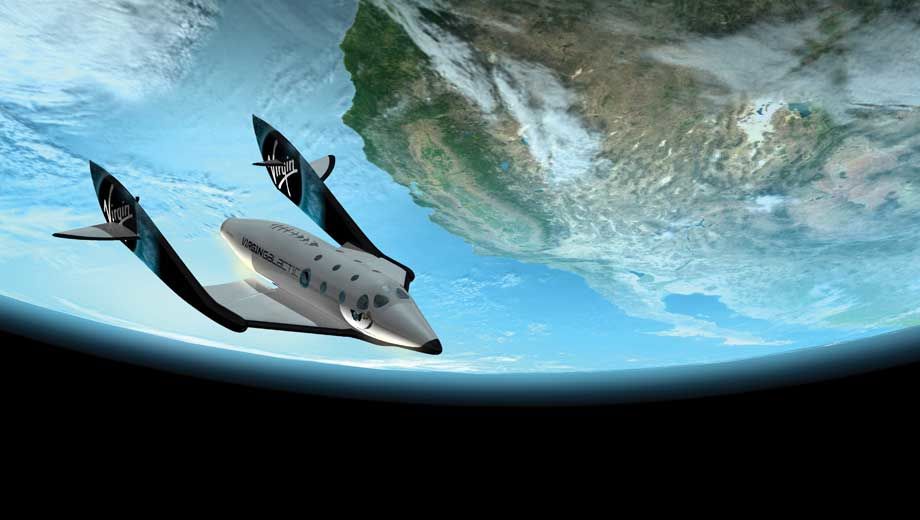Branson: launch of first Virgin Galactic spaceflight now 2014

Richard Branson's ambitious Virgin Galactic venture into space probably won't lift off until sometime in 2014 or even later, says the British billionaire.
Branson hoped the first flight would take place by the end of this year, with the two-stage White Knight Two craft taking off from Virgin Galactic's commercial spaceport located in the New Mexico desert.
But despite having sold over 400 tickets at $200,000 per seat for the two-hour ride, which will carry passengers 100km (62 miles) above Earth, Branson says the launch date keeps being pushed back, and back, and back...
According to AAP, Branson has "stopped counting" the days to the first launch, saying it will be "at least another 12 or 18 months" before Virgin Galactic can finally head for the stars.
Check out out amazing photo tour of Richard Branson's Virgin Galactic Spaceport.
Of course, as nice as 'space tourism' is, the real prize for Branson will be a return to the superfast era of the Concorde, only this time even quicker, with scheduled sub-orbital shuttles to whisk you from Sydney to London in four hours.
As Australian Business Traveller reported last year, Brett Godfrey – former founding CEO of Virgin Blue, long-time Branson buddy and holder of a ticket into space – believes that sub-orbital services will be "the next level" beyond supersonic, with substantial appeal to business travellers.
"In another 10 or 15 years it will be $20,000 – it will be no more than a first-class ticket somewhere" Godfrey says, "and then eventually they will be able to get a slightly bigger rocket with a bit more fuel and they'll be able to get it so it goes trans-con and then around the world."
"It may not be in my lifetime that it goes commercial but I think it probably will."
How sub-orbital flights work – or, flying the Kangaroo Route in 2050
Virgin Galactic's space carrier is an aircraft in two parts, with the 'White Knight Two' transporter cradling the smaller 'SpaceShipTwo' passenger craft beneath its wings.
White Knight Two, which is smaller than a Boeing 737, lifts off from a normal runway and climbs at subsonic speeds to 50,000 feet (just over 15,000 m).
At this point SpaceShipTwo -- half the width of the 737 and only 18 metres (60 feet) long – detaches and fires its own boosters to soar to 110,000 m. That's about twice as high as Concorde used to cruise.
At this height, with the atmosphere becoming thinner and friction from air decreasing, the passenger shuttle can hit speeds of 4,000 km/h before turning off its engines, coasting along near the rim of space and gliding down to earth.
(The White Knight Two carrier vehicle has long since headed home to pick up its next cargo.)
With London and Sydney being just over 17,000 km apart, SpaceShipTwo travelling at 4,000 km/h and the earth far below spinning at 1,700 km/h, that's almost exactly three hours from Sydney Harbour to the Thames.
Add half an hour for liftoff and half an hour to glide down, and you turn the long-haul Kangaroo Route into a breezy four hour hop – less time than it currently takes from Sydney to Perth.
The current SpaceShipTwo design carries six people in relative comfort. Concorde flew over forty years ago, and its transatlantic services established that people are happy to sit in seats that are less comfortable than today's premium economy seats to cut their flight time in half.
Virgin Galactic's spacebound superjumbo
Of course, today's White Knight Two carrier aircraft is no larger than a Boeing 737.
Just imagine the numbers of people that could be carried by a White Knight aircraft the size of an Airbus A380, which can lift over five times as much as White Knight Two.
(The massive Antonov An-225 cargo aircraft can lift twenty times as much, and the Antonov was designed thirty years ago. This idea clearly has room to scale up.)
It's not a huge stretch to consider that future SpaceShipTwo-type aircraft the size of a medium-range jet like the A320 could be whizzing over a hundred passengers up into orbit and dropping them back down across the planet a few hours later.
Nor is it beyond the bounds of imagination to think that one enormous carrier could take off from Sydney carrying multiple smaller landing craft destined for multiple destinations across the globe.
"Welcome onboard Virgin Galactic's nine o'clock departure for New York, London, Tokyo, Rio and Johannesburg. Fasten your seatbelts."
Follow Australian Business Traveller on twitter: we're @AusBT.




11 Mar 2012
Total posts 180
Umm, no. SpaceShipTwo can not carry enough juice to sustain a 1-hour cruise, let alone 4 hours, at those speeds.
Besides, the boosters are there just to take it up to the flight level and to accelerate not to cruise per se.
Hi Guest, join in the discussion on Branson: launch of first Virgin Galactic spaceflight now 2014